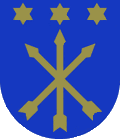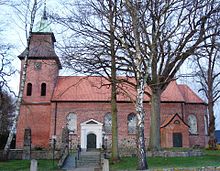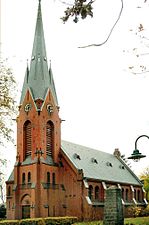Stockelsdorf
| coat of arms | Germany map | |
|---|---|---|

|
Coordinates: 53 ° 53 ' N , 10 ° 39' E |
|
| Basic data | ||
| State : | Schleswig-Holstein | |
| Circle : | Ostholstein | |
| Height : | 18 m above sea level NHN | |
| Area : | 56.7 km 2 | |
| Residents: | 16,998 (Dec. 31, 2019) | |
| Population density : | 300 inhabitants per km 2 | |
| Postcodes : | 23612, 23617 | |
| Primaries : | 04504, 04505, 04506, 0451 | |
| License plate : | OH | |
| Community key : | 01 0 55 040 | |
| LOCODE : | DE SKF | |
| Address of the municipal administration: |
Ahrensböker Strasse 7 23617 Stockelsdorf |
|
| Website : | ||
| Mayoress : | Julia Samtleben ( SPD ) | |
| Location of the community of Stockelsdorf in the Ostholstein district | ||
Stockelsdorf is a municipality in the Ostholstein district , Schleswig-Holstein . Stockelsdorf is located directly on the northern city boundary to the Hanseatic city of Lübeck and forms an agglomeration with this city and the east bordering city of Bad Schwartau . In addition to the core town of the same name, the municipality includes the villages of Arfrade, Curau , Dissau, Eckhorst, Horsdorf, Klein Parin , Krumbeck, Malkendorf, Obernwohlde and Pohnsdorf as districts. In terms of population, Stockelsdorf is the second largest municipality in Schleswig-Holstein after Henstedt-Ulzburg without city rights .
Geography and traffic
Stockelsdorf is located north of Lübeck and on Landesstraße 332 (formerly Bundesstraße 206 ). City bus routes run by Stadtverkehr Lübeck (SL) to Lübeck and Bad Schwartau run from Stockelsdorf, and Stockelsdorf is also served by regional bus routes operated by Autokraft .
From 1916 to 1967 Stockelsdorf was the station of the Lübeck-Segeberger Railway .
history
Stockelsdorf was first mentioned in a document in 1320. Since there is already talk of a village (villa) that is owned by knighthood, the origins of the place must be much earlier.
Historical source
In a document dated February 25, 1320 (issued in Hamburg), 3 (!) Holstein counts, namely Count Adolph VII and his cousins, Count Gerhard III. (the great) and Johann III. (der Milde) , the sale of the villam stochelstorpe from the knight Burchard von Otteshude ( Borchardus de Otteshudhe ) to the Lübeck citizen Emelrich Pape ( Emelrico dicto Papen ). As early as 1333, the future mayor of Lübeck, Bertram Vorrade, acquired Stockelsdorf.
Further development
Other nobles from Lübeck later came into possession of the estate ( v. Brömbsen, v. Höveln, v. Calven, v. Dame ). In 1925 the estate was dissolved by the widow of the last owner ( Major Lembcke ). In 1534, a partial peace of the Count's feud , the Peace of Stockelsdorf, concerning Holstein , was agreed here at the gates of the Hanseatic city. Until the Greater Hamburg Act in 1937, Stockelsdorf belonged to the Free State of Oldenburg ( Lübeck region ). The districts of Dissau, Malkendorf and Krumbek as well as half of Curau were up to this point in time as exclaves parts of the Hanseatic city of Lübeck. There are two listed buildings in the central town: the Stockelsdorf church from 1903 and the Stockelsdorf manor house from 1761, which was recently renovated and now houses the citizens' hall. In addition, attempts are currently being made again to establish a restaurant here after a first attempt in 2005 failed. The customs barn on Landgraben , built in 1839 and representing the Lübeck border, fell victim to the expansion of federal highway 206 to Bad Segeberg in 1968 .
Stockelsdorf faience
On the estate of the Stockelsdorf manor house, the landowner Georg Nicolaus Lübbers founded a faience manufacture in 1772 . The director was the very experienced Johann Georg Buchwald , who had previously managed similar factories in Eckernförde (1765) and Kiel (1768). Some of the high -quality works of the Stockelsdorf faience factory are still preserved today and are exhibited in the St. Anne's monastery and in the Behnhaus in Lübeck, including an oven . Because of the great resistance of the Lübeck potters and the beginning importation of cheap English earthenware , the factory had to be closed again in 1786. Shortly afterwards, Buchwald's director moved to Bad Schwartau and began producing pottery at his own expense, but this was not very successful.
Jewish community
In the 18th century - following the Moislinger model - Jews were granted the right to settle. The Jewish cemetery is mentioned in 1799 - the Jewish school was attended by 18 children in 1840.
Historic districts
Mori
Mori is a former Lübsches estate and is first mentioned in 1333. Initially as Neuhof (Nyger Hof) ; in 1410 as to der murryen (morrien) . The owner was Bertram Vorrad - later his cousin Tiedemann Vorrad . When he died in 1385 without an heir, the farm had to be sold. After a long dispute over inheritance, it was acquired by Wilhelm von Calven in 1410 . Until 1528 Mori belonged to Gut Stockelsdorf as a Meierhof , then van Calven's grandsons shared the farms. In 1636 the family was no longer able to hold the farm after a brother-in-law had carried out road robbery from there and was executed in Lübeck for it. The buyer of the run-down farm, Lübeck councilor Adrian Müller, had a new mansion built in the Renaissance style with a keep to protect the villagers during the Thirty Years' War . His son had a chapel built, which existed until 1821. Later the property belonged to u. a. Anton von Lüneburg . After several other changes of ownership, Mori became the property of the Plessings . The Royal Bavarian. Consul in Lübeck, Carl Theodor Plessing , had the old mansion made habitable again from 1900 and managed the estate until the war. After the war he gave it to his son and moved to the Hanseatic city. The estate, which was already parceled out in the 19th century, was dissolved in 1934 and came into the possession of the State of Schleswig-Holstein. Mori was used as a senior citizens' home from the 1950s ( Morierhof ). The property with the manor house is now (after the regional reform of 1970) a few meters outside the Stockelsdorf municipality boundary and belongs to the Groß Steinrade district of Lübeck .
Fackenburg
Fackenburg is the area between Segeberger and Morier Straße. In 1751 the manager of Mori, Philibert Fack , received some land as well as brewing and distillery rights from the landowner of Albedyll . Good sales were expected due to the immediate location on the Lübeck city limits, which is marked by the Fackenburger Landgraben . The property was soon called (genitive and somewhat French) Facken (s) Bourg . It developed into a busy trading center, where not only beer but also goods of all kinds were offered. Fackenburg was often used by the Lübeckers because of the low prices, as the strict guild regulations, as they prevailed within the Lübeck city walls, did not apply here. The Fackenburger Allee following the Krempelsdorfer Allee is still a reminder of those times.
Ravensbusch
Ravensbusch is a residential area belonging to Gut Mori. Initially only individual cottages, later also multi-family houses. Ravensbusch became the location of a school early on (see school route). The current school building dates from 1907.
Mariental
This core of the settlement probably goes back to Maria Catharina von Lübbers , wife of Georg Nicolaus von Lübbers , who bought the Stockelsdorf estate in 1761. Lübbers is considered the founder and great promoter of faience production in Stockelsdorf (see above).
Holzkamp
The Holzkamp farm belonged to Gut Mori as a pertinence. It was a storage place for the firewood destined for Lübeck. Holzkamp has a special meaning in the history of the Mennonites in Schleswig-Holstein. Geerlinck Roosen leased Holzkamp in 1566 from the then landlord to Mori Thomas von Calven. In addition to farming, he ran powder-making here. The Roosen family stayed at Holzkamp for over 100 years. In Altona (see Gerrit Roosen ) she played a major role in trade and in the Mennonite community.
Today Holzkamp is part of the mixed area Brandenbrook / Holzkamp . Commercial areas and residential developments have arisen here.
Krumbeck
The Krumbecker Hof (180 ha), incorporated in Stockelsdorf in 1937, has belonged to the Heiligen-Geist-Hospital Foundation in Lübeck for over 600 years . In 1986 the citizens of Lübeck decided that the foundation's goods should only be managed according to the principles of organic farming. This has been done at the Krumbecker Hof since 2004 in accordance with the Demeter guidelines. The courtyard has a protected passage barn , which is now used as a culture barn.
present
Today Stockelsdorf is a large community with ten outlying villages and a total of over 16,000 inhabitants. The community has two Evangelical Lutheran churches: one in the central town of Stockelsdorf and one in Curau. Stockelsdorf is connected by bus lines operated by Stadtverkehr Lübeck GmbH. Various businesses are operated in two industrial areas. One of the largest discos in Schleswig-Holstein (the “MegaParc” Lübeck, formerly known by name as Atrium Lübeck and Abaco ) was also located there. The expansion of the federal motorway 20 from the Lübeck junction in the direction of Bad Segeberg has been completed, the Geschendorf junction west of Stockelsdorf was opened to traffic on July 28, 2009.
schools
-
Elementary schools
- Ravensbusch primary school, Segeberger Strasse (opened in 1907), 218 students in 8 classes
- Gerhart-Hauptmann-Grundschule, Breslauer Straße (opened 1969), 200 students in 9 classes
- Erich-Kästner-Grundschule, Dorfstraße (opened 1991), 218 students in 9 classes
-
Community school
- Gerhard Hilgendorf Community School Stockelsdorf, Rensefelder Weg, (ex Realschule Stockelsdorf (opened 1976)), 580 students in 24 classes
Student numbers from the school year 2019/2020.
Churches

Up until the beginning of the 20th century, Stockelsdorf belonged to the parish of Rensefeld .
Since 1969 there are two ev.-luth in Stockelsdorf. Parishes:
- Stockelsdorf I.
- Stockelsdorf II (Stockelsdorf-Mori with Mori, Eckhorst, Gr. Steinrade, Bohnrade and Bargerbrück)
They use the Stockelsdorf church together .
- There are also in the district Curau the Curauer Church .
Sports
The general gymnastics and sports club (ATSV) Stockelsdorf from 1894 e. V. offers various sports, including soccer, handball, archery, tennis, gymnastics, apparatus and competitive gymnastics.
telecommunications
- 158 meters high telecommunications tower of Deutsche Telekom AG 53 ° 54 '25 " N , 10 ° 38' 31" O . The tower is also used to broadcast television programs in DVB-T mode.
politics
Community representation
The municipal elections on May 6, 2018 led to the following result:
coat of arms
Blazon : "In blue, a bundle of three golden arrows pointing upwards with their points pointing upwards, overlaid by three golden six-pointed stars."
Twin cities
- Le Portel , Pas-de-Calais department , France
- Okonek , Greater Poland Voivodeship , Poland
The parish maintains partnerships with Tanzania and Romania .
Personalities
- Fritz Scheel (1852–1907), conductor
- Karl Fick (1881–1945), politician, member of the state parliament (SPD)
- Herbert Kühn (1910–1976), sculptor
- Ernst Joachim Völker (* 1934), acoustician, building physicist and university professor
- Ulrich Meyenborg (* 1940), politician (SPD)
- Philip Schlaffer (* 1978), a neo-Nazi dropout
- Sven-Sören Christophersen (* 1985), German national handball player
Others
The Lübeck-born author and backward speaker Bernhard Wolff discovered his talent for the creative use of language as a ten-year-old on the town sign of Stockelsdorf, which sounded much more interesting to him when read backwards than frodslekcots .
Web links
Individual evidence
- ↑ North Statistics Office - Population of the municipalities in Schleswig-Holstein 4th quarter 2019 (XLSX file) (update based on the 2011 census) ( help on this ).
- ^ Annaluise Höppner: Lübeck. A Hanseatic city makes history. Weiland publishing house. Lübeck 1986, ISBN 3-87890-060-0 .
- ↑ Max Steen: Alt Schwartau - history and stories. Verlag Gustav Weiland, Lübeck 1980 (2nd edition)
- ^ Chronicle of Mori
- ^ Johann Friedrich Kratzsch : The newest and most thorough alphabetical lexicon of all localities in the German federal states. 2nd department, 1st volume (1845) in the Google book search, Naumburg 1845, p. 672 f.
- ↑ BC Roosen: History of the Mennonite community in Hamburg and Altona. Volume 1, Hamburg 1886, p. 22
- ^ Community of Stockelsdorf: Economy
- ↑ Bodo Fabian: The Krumbecker Hof - a Lübsche story. In: Lübeckische Blätter 184 (2019), Heft 13 ( digitized version), pp. 214f
- ↑ Statistical Office for Hamburg and Schleswig-Holstein: Directory of general education schools in Schleswig-Holstein 2019/2020
- ^ Website of the ATSV Stockelsdorf from 1894 e. V.
- ↑ Schleswig-Holstein's municipal coat of arms
- ↑ Heike Dierbach: Das ßolhcsdarrhaf - The Hamburg Bernhard Wolff is a backspeaker and memory artist









